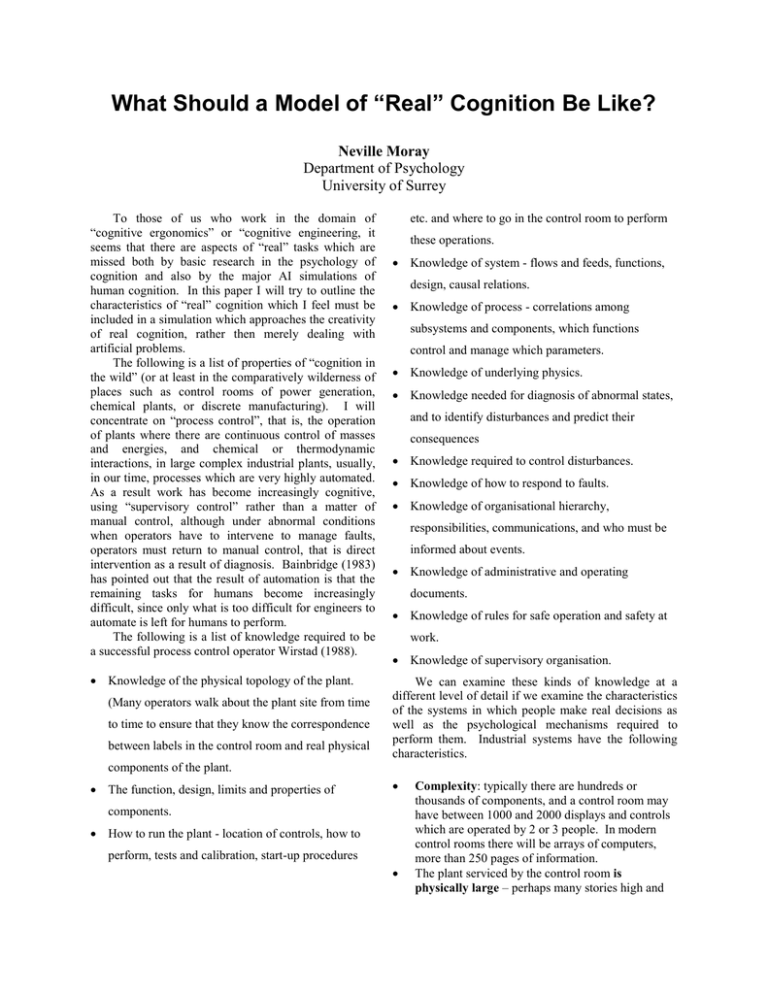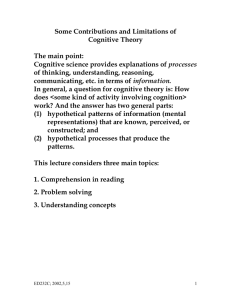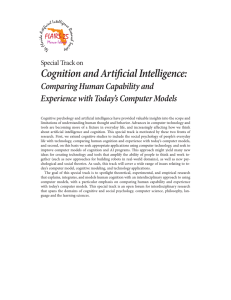What Should a Model of “Real” Cognition Be Like? Neville Moray
advertisement

What Should a Model of “Real” Cognition Be Like? Neville Moray Department of Psychology University of Surrey To those of us who work in the domain of “cognitive ergonomics” or “cognitive engineering, it seems that there are aspects of “real” tasks which are missed both by basic research in the psychology of cognition and also by the major AI simulations of human cognition. In this paper I will try to outline the characteristics of “real” cognition which I feel must be included in a simulation which approaches the creativity of real cognition, rather then merely dealing with artificial problems. The following is a list of properties of “cognition in the wild” (or at least in the comparatively wilderness of places such as control rooms of power generation, chemical plants, or discrete manufacturing). I will concentrate on “process control”, that is, the operation of plants where there are continuous control of masses and energies, and chemical or thermodynamic interactions, in large complex industrial plants, usually, in our time, processes which are very highly automated. As a result work has become increasingly cognitive, using “supervisory control” rather than a matter of manual control, although under abnormal conditions when operators have to intervene to manage faults, operators must return to manual control, that is direct intervention as a result of diagnosis. Bainbridge (1983) has pointed out that the result of automation is that the remaining tasks for humans become increasingly difficult, since only what is too difficult for engineers to automate is left for humans to perform. The following is a list of knowledge required to be a successful process control operator Wirstad (1988). Knowledge of the physical topology of the plant. (Many operators walk about the plant site from time to time to ensure that they know the correspondence between labels in the control room and real physical etc. and where to go in the control room to perform these operations. Knowledge of system - flows and feeds, functions, design, causal relations. Knowledge of process - correlations among subsystems and components, which functions control and manage which parameters. Knowledge of underlying physics. Knowledge needed for diagnosis of abnormal states, and to identify disturbances and predict their consequences Knowledge required to control disturbances. Knowledge of how to respond to faults. Knowledge of organisational hierarchy, responsibilities, communications, and who must be informed about events. Knowledge of administrative and operating documents. Knowledge of rules for safe operation and safety at work. Knowledge of supervisory organisation. We can examine these kinds of knowledge at a different level of detail if we examine the characteristics of the systems in which people make real decisions as well as the psychological mechanisms required to perform them. Industrial systems have the following characteristics. components of the plant. The function, design, limits and properties of components. How to run the plant - location of controls, how to perform, tests and calibration, start-up procedures Complexity: typically there are hundreds or thousands of components, and a control room may have between 1000 and 2000 displays and controls which are operated by 2 or 3 people. In modern control rooms there will be arrays of computers, more than 250 pages of information. The plant serviced by the control room is physically large – perhaps many stories high and many hectares in extent. Operators need to understand the physical topology of the plant. The system is typically open – that is, there is always the possibility of completely new events which have not been foreseen by designers. The system changes over time. It is never possibgle3 to know all the properties of a system, and many variables may not be observable Events take place in real time and against deadlines. Systems are dynamic on many different time scales. Cognition is often externalised through notes, computers, etc. Not all knowledge is in the head of the person thinking. Cognition is typically social and takes place among the members of teams and groups. Problems are seen as about physical causality, not about logical consistency. Because of the limits of attention dynamics, not all variables are monitored by operators, Instead they make use of mental models which are homomorphic mappings of the physical system. Operators simplify systems by thinking of them as made up of partly independent subsystems which can be considered independently. Operators make extensive use of mental look-up tables rather than reasoning. Operators have many mental models of a single system which represent different levels of an abstraction hierarchy, different levels of partwhole decomposition, and different types of causality. Operators change the levels or types of cognition from moment to moment within a problem. These are well-characterised by Rasmussen’s typology of skill-based, rule-based and knowledge-based behaviour. This hierarchy has been suggested as a model of cognition, but has not been implemented. “Recognition primed” decision making is relevant at skill-based and rule-based levels, but reasoning is required at knowledge-based level. Artificial cognition should mimic the errors made by humans as well as providing successful reasoning. The form of errors reflect the skill, rule, knowledge typology. Operators try to avoid reasoning and use rules whenever possible. Reasoning is rare in the wild. There are a number of characteristics of diagnostic reasoning which are considered characteristic of operators, but which are sometimes thought of as errors, and sometimes as strategies. For example, operators fixate rapidly on a single hypothesis, and seek evidence to support it, rather than testing hypotheses. Mental models are often unstable and do not support hypothesis testing well unless they have become rule or skill-based. Identical information may have different meaning depending on context. Context is as important in cognition in determining behaviour. Communication between operators is extremely important, and can both help and hinder reasoning. But it is central to real decision making. “Mental models” have a variety of forms which support skill, rule and knowledge based behaviour. Almost the only kind of reasoning which is not seen in real settings is that most commonly investigated in basic research in cognition, i.e. deductive reasoning on logically closed problems such as those investigated by Johnson-Laird. (I will review some suggestions whi8ch have been made for modelling “real” behaviour). Suggested readings (*not intended to be complete) Bainbridge, L. 1992. Mental models in cognitive skill. In A. Rutherford, Y.Rogers and P.A.Bibby (eds.), Models in the Mind, London: Academic Press. Bainbridge, L. 1974. Analysis of protocols from a process control task. In E.Edwards and F.Lees (eds.), The Human Operator in Process Control, London: Taylor and Francis. 146-158. Bainbridge, L. (1983). The ironies of automation. Automatica, 19, 755-779. Baron, S. Muralidharan, R., Lancrafty, R. & Zacharias, G. 1980 PROCRU: a model for analyzing crew procedures in approach to landing. Technical Report No. 4374. Cambridge, MA: Bolt, Bernanek and Newman, Inc. Edwards, E. & Lees, F. (1974a) The human operator in process control. London: Taylor and Francis Edwards, E. & Lees, F. (1974b). Process Control. London: Institute of Chemical Engineers. Iosif, G. (1969b). Influence de la correlation fonctionelle sur parametres technologiques. Revue Roumanien de Science Social-Psychologique, 13, 105-110. Johnson-Laird, P. N., (1983). Mental models. Cambridge, Mass.: Harvard University Press. Moray, N. 1989. A lattice theory approach to the structure of mental models. Philosophical Transactions of the Royal Society of London, series B, 327, 447-593. Moray, N. (1997). Models of Models of . . . . Mental Models. In T. B. Sheridan and T. Van Lunteren (Eds). Perspectives on the Human Controller. Mahwah, NJ: Lawrence Erlbaum. 271-285. Moray, N. (1999). Mental models in theory and practice. Attention and Performance XVII, Cambridge, MA: MIT Press.. Rasmussen, J. (1986). Information processing and human-machine interaction: an approach to cognitive engineering. Amsterdam: North-Holland. Rasmussen, J., Pederesen, A-M., & Goodstein, L. (1995). Cognitive Engineering: concepts and applications. New York: Wiley. Reason, J. 1990, Human error, Cambridge: Cambridge University Press. Sanderson, P.M. 1991. Towards the model human scheduler. International Journal of Human Factors in Manufacturing, 1, 195 -215. Sasou, K., Takano, K., & Yoshimura, S. (1995) Development of SYBORG (simulation system for behavior of an operating group). Proceedings 5th European conference on cognitive science approaches to process control. Espoo: Technical Research Centre of Finland. pp.368-376. Woods,D.D., Roth, E.M., & Pople, H. 1987. An artificial intelligence based cognitive environment simulation (CES) for human performance assessment. technical report NUREG/CR-4862. Washington, D.C.: US Nuclear Regulatory Commission. Wirstad, J. (1988). On knowledge structures for process operators. In L. P. Goodstein, H. B. Anderson, and S. E. Olson. Wohl, J.G. 1982. Maintainability prediction revisited: diagnostic behavior, system complexity, and repair time. IEEE Transactions on Systems, Man and Cybernetics, SMC-12, 241-250.



